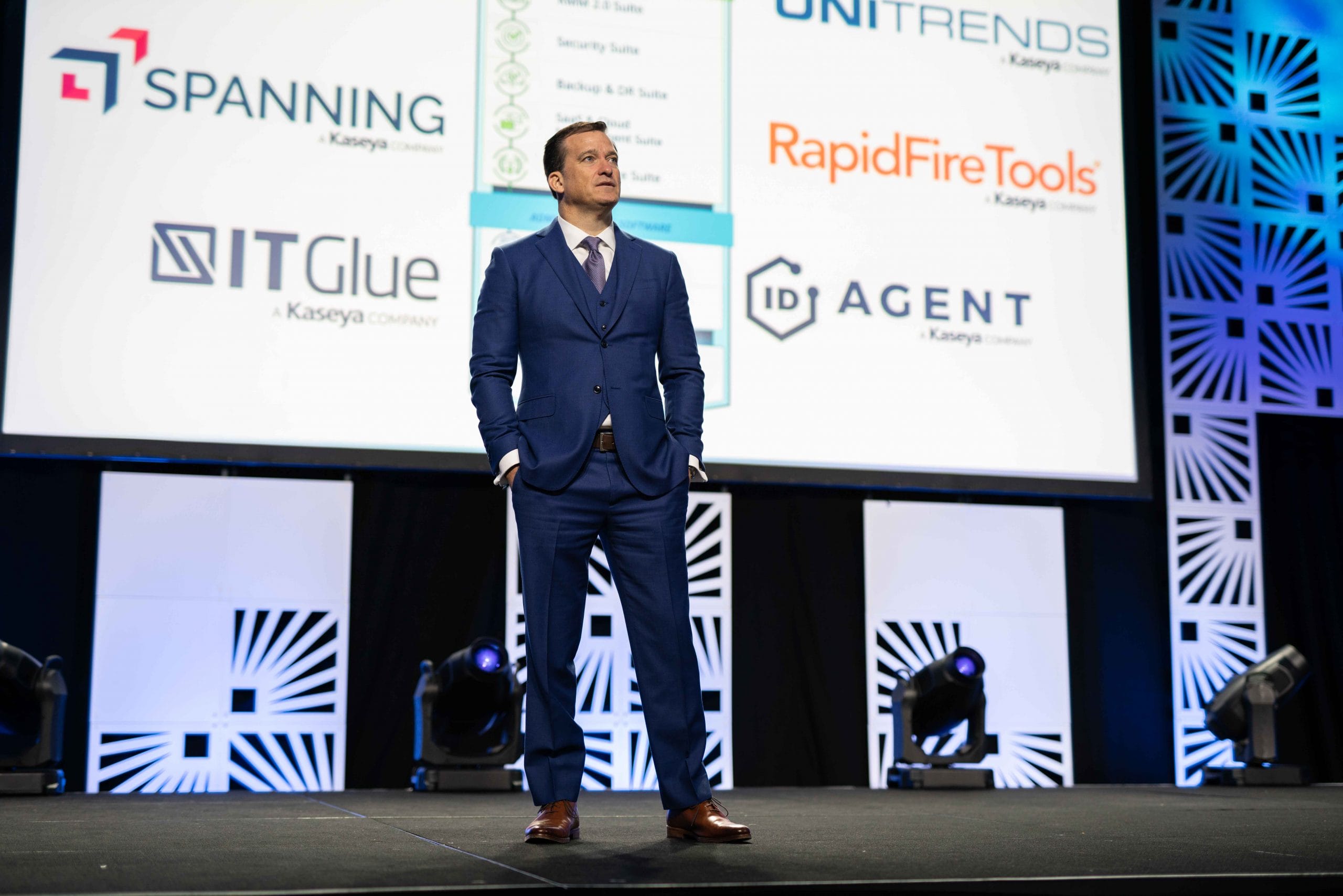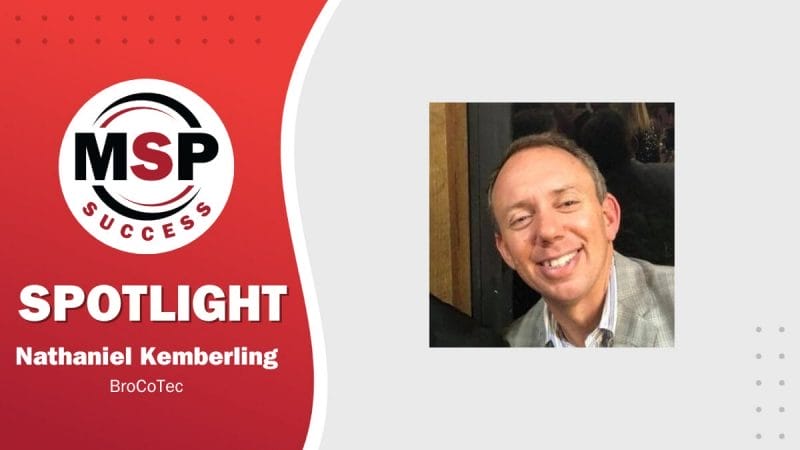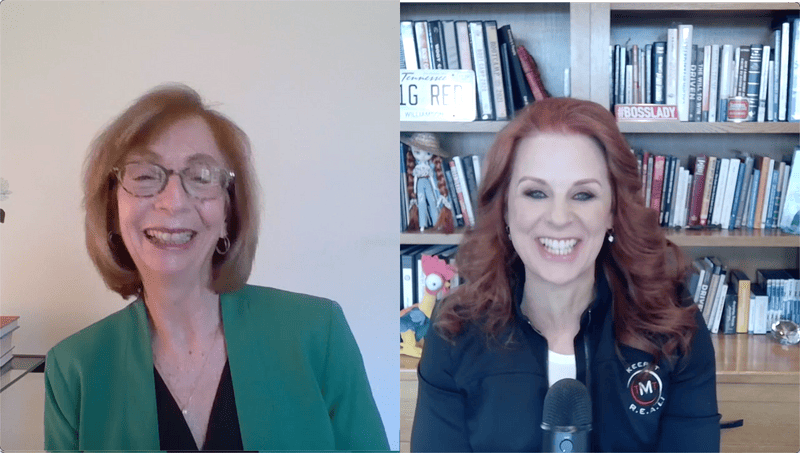Back in 2015, Robin Robins invited the recently appointed CEO of Kaseya, Fred Voccola, to speak to her Producers Club members. At the time of their interview, it was no industry secret that when Voccola accepted the role, he had a long and arduous journey ahead of him to return the company to its former market leadership position with MSPs.
In the five years since, Voccola has implemented a customer-first approach and has worked to bring solutions that make the lives of IT leaders around the globe easier and more predictable.
After witnessing first-hand Kaseya’s immense growth over the last four years, Robins recently sat down to chat with Voccola once again and discussed his approach for truly transforming this company into a force to be reckoned with.
ROBINS: When we talked in 2015, you had just taken the helm at Kaseya at a time when it had been losing credibility and popularity in the channel. You came in knowing that you had a big hill to climb, but you embraced it. What was it about your background that prepared you for taking on this challenge?
VOCCOLA: I started my first technology company when I was in college (early- to mid-‘90s), and it was purely by accident. I did it because I couldn’t get hired by Wall Street. Maybe I wasn’t smart enough or didn’t have enough of whatever else Wall Street was looking for. But it turned out to be the best thing that ever happened to me because, without realizing it, I walked into what is now the largest transformation of business investment in the history of mankind: the IT revolution.
IT has changed the way business is conducted across the world like nothing before it, and it happened in a period of only eight years.
If you remember back to the late ‘80s and the early- to mid-‘90s, technologies like ERP, office productivity software, relational data bases, supply chain software, and data warehousing came to the scene. Then, five years or so later, the internet came into play. It is very rare that any kind of innovation changes absolutely everything and everyone, but the IT revolution did just that.
The IT revolution first started with big enterprises and governments because implementing the early systems took armies of people and resources just to get basic functionality in place. However, everyone rushed to do it because that basic functionality provided so much value to the organization deploying it. The amount of investment going into enterprise technology and enterprise IT was staggering. I was lucky enough to start my career in software and technology right when that was happening. So, like many people my age who are in the technology space today, I earned my bones in the enterprise.
I then saw and experienced the rapid rate of technological advancement. After a few years, these powerful systems became easier to implement. Their cost came down. Instead of needing 100 people to implement a system, it only required five, and then three, and then two. So, what we started seeing around 2010–12 was small- to mid-size businesses being able to consume technology to get the same functionality that the enterprise had benefited from just 5–10 years prior. That began the current SMB revolution that we are in the early stages of now.
I lived through this transformation, and that allowed me to really understand what was happening on a macro level.
ROBINS: Why Kaseya? What made it a unique challenge for you as a CEO?
VOCCOLA: That trend that we just discussed — the trend of SMBs adopting technology at such a massive rate — well, the tip of the sword for that movement is the MSP. MSPs are the vehicle for how small and medium businesses obtain and consume technology.
If you think about what technology means for a small business, it starts with the endpoint. Yes, security, compliance, disaster recovery, and a million other aspects are all important, but fundamentally, every piece of technology has to start at the endpoint. So, why Kaseya? In 2015, Kaseya had (and still has) the best industry-leading product and core technology that allows an IT professional to most efficiently manage all kinds of endpoints like PCs, servers, VMs in the cloud, mobile devices, and network devices.
MSP technicians have to worry about every aspect of technology, and you often see the same technicians doing all elements of IT management for all their customers. Most MSPs are not large enough to have complete resource specialization like the IT shop of a Citibank has. You rarely find an MSP that has dedicated people answering the service desk, another dedicated group focusing only on patching machines, another managing and reporting on compliance, and yet another worrying about backup, etc. In most MSPs, it’s the same person doing all of these jobs. We call this individual the multifunction IT professional.
Back in 2015, what the market did not have was one platform that let that multifunction technician do all of this from one place. The workflow of an MSP technician involves up to seven or eight different functional areas of IT. At the time, Kaseya had the best foundation to create an integrated platform for the multifunction IT professional because its remote systems management platform already automated endpoint management. From that same platform, I figured we could build in backup, compliance, and security, and we could do it for half the cost compared to an MSP having to piecemeal together seven or eight products from seven or eight different vendors. That can really make a huge impact on a 12-person, 20-person, or 100-person MSP.
So why did I take a chance on Kaseya back in 2015? Because Kaseya had the foundation and technology of the leading endpoint management technology in place that was required for building the industry’s first and only multifunctional IT management platform, IT Complete.
ROBINS: So, you saw this opportunity, you evaluated it, and you put together a game plan. Was there anything that surprised you?
VOCCOLA: The first surprise was just how angry Kaseya’s customers were back then. For the first three months, all I did was talk to customers who were ready to abandon us. Of course, it wasn’t fun to hear, but I viewed this as a huge opportunity because these customers, while angry, also cared enough to take the time to talk with me. I had about 250 one-on-one conversations with these frustrated customers during my first year on the job, and these conversations validated the strategy we had for turning around the company. It reinforced the fact that what Kaseya does for our customers is extremely important.
Another surprise was how massive the MSP market is and, at the same time, just how small of a community it is. At Kaseya, we account for about 144,000 MSPs around the world. Some of them are one-person shops and some are 5,000-person shops, but they are all categorized as MSPs. Of those 144,000, the majority are successful businesses. However, I’d estimate that upward of 90% feel they don’t have the training, experience, or skill set required to keep growing their businesses to the next level. Sales, marketing, service delivery: These are the challenges that most MSPs around the world face.
The last surprise was how phenomenal and passionate the people (employees) underneath the executive team at Kaseya were. Thank goodness these people stuck around during the hard times, because they are the ones who genuinely and authentically care about our MSPs. It’s because of their dedication to making MSPs’ lives more convenient that we’ve reached the place where we are today.
ROBINS: Where are you today?
VOCCOLA: We are growing very rapidly and looking to keep getting better. We’ll do upward of $300 million this year. To compare, in 2015, we were bringing in approximately $75 million. Furthermore, our retention rates are over 94%, which demonstrate that customer satisfaction levels are exponentially better than they were previously, and we are very profitable, looking to do over $75 million in profit this year.
ROBINS: Kaseya sounds like a force to be reckoned with. What did you change about the company’s mission to secure that growth?
VOCCOLA: The biggest change was that we shifted our company culture back to one of “making our customers successful.” Period. In fact, everything that Kaseya does is now customer-centric. We have approximately 1,150 employees around the world (we had 350 when I joined), and I fundamentally believe that if you ask every single employee at Kaseya what our mission is right now, every one of them would say the same thing: We put customers first. However, had you asked that question four years ago, you probably would have gotten 350 different answers. We are not perfect, and we make lots of mistakes. However, with that focus, we will keep doing more things right, and we hope and believe that our customers’ businesses are better because of it. Our data shows us that a Kaseya MSP is growing much faster (approximately 30%) than the overall MSP market and is about 15% more profitable than the average MSP. That is something that we take a lot of pride in.
ROBINS: You’ve obviously experienced a lot of acquisitions and growth, but you mentioned that the vision you’re hoping for is this fully integrated and unified platform that MSPs can use. Is that a reality today? When do you think that’s going to be a reality, and is that the future of Kaseya?
VOCCOLA: It’s a reality today, and it’s going to continue to get better and better. We call it IT Complete. That’s not a super complex or fancy name (obviously) but it is precisely descriptive. IT Complete is really an integrated, complete platform of technologies available under one pane of glass for a fraction of the cost of what an MSP would have to pay if they were to cobble together solutions from multiple vendors. Essentially, an MSP should be doing at least seven different things for every one of their customers. They should be managing their clients’ endpoints; providing security, compliance, and workflows; handling their backup and disaster recovery and cloud environment; and be documenting and organizing all of the technical and business content for them.
The problem is that, traditionally, these seven services required a lot of different products. Endpoints can be network endpoints, mobile endpoints, PCs, laptops, VMs in the cloud, servers, etc., and each one requires a different management tool. Backup requires backup solutions, security requires security solutions, etc. If I’m an MSP and I have nine technicians, these technicians have to deliver most if not all of the service stack for each customer. At that point, I’m using a remote monitoring and management product to manage the patching and build the automation. Then, I must turn to a different product with a different interface and different credentials, and I have to then go for that customer and set all the backup routines and monitor those in a different place. Then, I have to go and make sure all the threats are being monitored. I have to make sure that security is in place, using different products with different interfaces and little to no integrations to my workflow. And so on and so forth.
But when technicians use Kaseya IT Complete, they’re using our backup products and our RMM products, all of which have the same look and feel and are integrated at a workflow level. Security, network management, endpoint management, compliance, backup, disaster recovery, cloud management, and billing management are integrated in one convenient place. And this is all available today.
While we will always remain an open-platform and integrate with third-party tools and vendors to support the heterogeneous environments of MSPs who want to leverage products from multiple vendors, IT Complete is our vision for the future. Most of our customers use parts of the IT Complete platform, but not all of it. And they use it in conjunction with products from some of our competitors. That is the way of the industry, and it is not going to change any time soon, so we are forced to make sure our platform remains open and that we keep and maintain integrations with non-Kaseya products. That being said, over time, customers are realizing the benefits of using more and more of IT Complete together.
A common trend we’re finding with our customers is that they’ll start using one of our products — whether it’s compliance, security, RMM, or backup — and see the other products that are available in the IT Complete stack. They think, “Wait a minute. I’m using Kaseya for backup, and a different product for RMM, but I can get all this integrated through the same interface if I use Kaseya’s RMM. Oh, and it’s 40% cheaper? I’m done. I’m doing it all day, and twice on Sunday.” For this reason, we’ve been manifesting IT Complete, which is why our growth rate is faster than anybody else’s in the industry. It’s really what’s driving the financial success that we have. Most importantly, it is making our customers more profitable, which is our ultimate goal.
ROBINS: A lot of people have predicted the demise of the MSP, claiming that within a few years, automation will completely take over. What are your thoughts on that?
VOCCOLA: Here’s the 50,000-foot-view answer: Anyone who is predicting the demise of the MSP is simply out of their minds and has zero understanding of what is going on in the business world. First, technology is getting more and more important to small- and mid-size businesses. Most of these companies cannot afford an internal IT department, so they will always get their technology from MSPs. The type of technology needs that these SMBs require will always be changing, but the technology will continue to be delivered by an MSP. Second, despite digital transformation, automation, and other emerging technologies like AI, SaaS, and machine learning, technology is actually getting more complicated for small businesses, so the SMBs will rely even more on their MSPs.
Think about it: The knowledge between a dentist and an IT person is getting wider and vaster as technology gets more advanced and powerful. Since most small businesses (like the dentist) today depend on technology more than anything else, who is going to deliver it to them? They’re not going to learn it themselves. It’s too hard, and they have a million other things to worry about, first of which is running a successful business.
Additionally, some people claim that the Cloud and SaaS are going to doom the MSP. Again, I couldn’t disagree more. Let’s assume that you have a SaaS application. How do you access those applications? You use some kind of an endpoint, but that endpoint has to be secured. You also have compliance around it. You have to monitor the network that’s providing access to that SaaS application. You have to configure the SaaS application. You know who’s goingto do all of that? An MSP. Instead of managing proprietary networks and applications, service providers are going to manage the relationships and connectability to those cloud service providers and SaaS applications.
In fact, I think we’re going to see MSPs taking a larger and larger chunk. Just look back in history at what happened in the enterprise in the early ‘90s. The big IT outsources came
about, and they built a huge industry serving companies with large IT staffs. This continues today. Why did that happen? Because General Motors is not an IT shop. General Electric is not an IT shop. So, what’s happening now? You’re seeing larger small-businesses or small to medium enterprises that have 6–10 IT people, and they can’t keep up.
So, MSPs are continuing to move upstream, and they are not only managing IT for small businesses; they’re also taking over parts of IT for the larger small-business and the small- to medium-sized enterprises. That’s going to continue. In the next five years, half of IT for companies of 5,000 employees or less will be delivered by managed service providers.
Our research data backs this up. We only charge when an MSP sells a managed service, right? So, we have transparency into the growth rates of our MSPs, and we know who their end customers are. This gives us the data to suggest that growth in this industry is nowhere near complete. I believe it’s going to continue for the next decade, as long as we continue to choose the right waves.
ROBINS: Any closing thoughts on this that you’d like to share with our readers?
VOCCOLA: All in all, I’m just excited for the opportunity that is before us and to see that Kaseya MSPs continue to grow about 30% faster than non-Kaseya MSPs. As a result of all the acquisitions we’ve done and the data we’ve been able to gather and study, we can see it. To get to witness and play a part in this industry growth has been tremendously rewarding. This may sound very cheesy, but I am so lucky and humbled to be able to lead a company like Kaseya with customers as amazing as ours in an industry that is always changing, evolving, and presenting new challenges. I’m excited to see what the next decade holds









